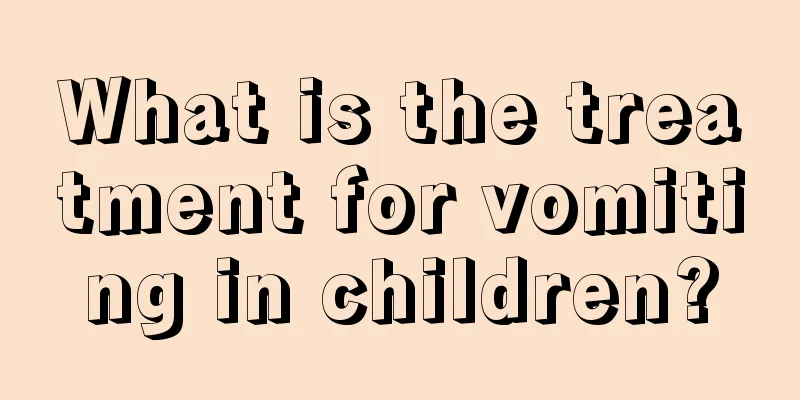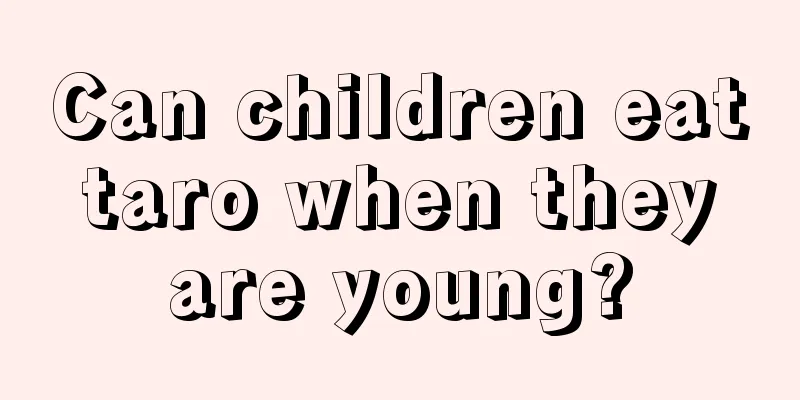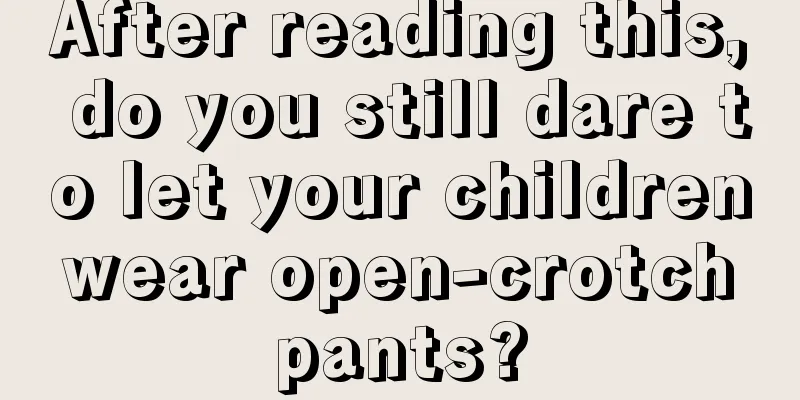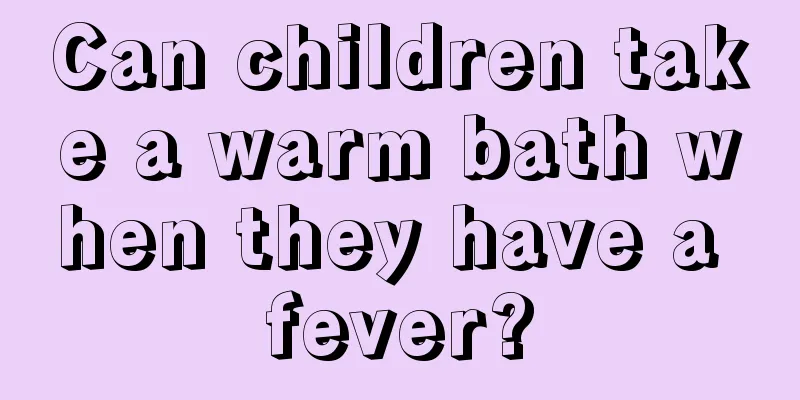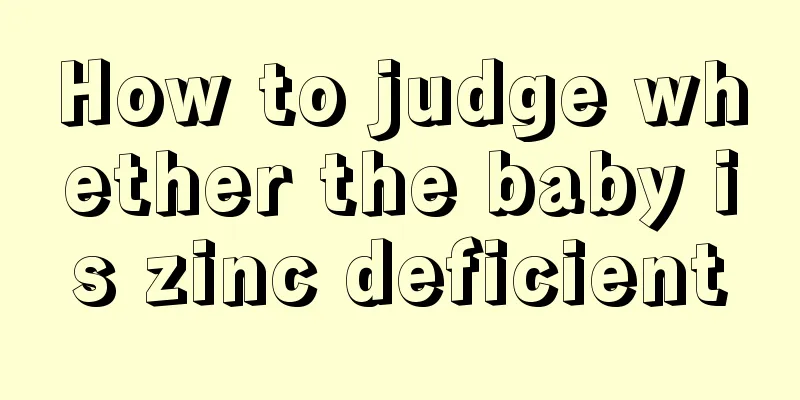Is it good for children to have early teething?

|
Many parents are very concerned about their children's development, and I believe that there are many parents who don't want to be involved in every detail of their children. As children grow up step by step, they will inevitably grow small teeth. However, some children's teeth do not grow according to normal development indicators, but instead grow prematurely. So is this a good thing or not? Next, let’s ask an authoritative expert to explain to you whether it is good or bad for children to have early teething? It's normal. The early or late eruption of teeth in children is mainly determined by genetic factors, nutrition and physical constitution. Usually, children start to grow teeth at 6-7 months after birth. Children with early teeth begin to grow teeth at 4 months, and children with late teeth will not grow teeth until about 10 months. Some children will not grow their first deciduous teeth until after 1 year old. This situation is related to the speed of bone growth during infancy. Late teething means that the child's bone growth is slower, while early teething means that the child's bone growth is faster. Of course, this is relative. As long as the late eruption of teeth is not caused by calcium deficiency or disease, it generally will not affect the future growth and development of bones. Tooth eruption time When a child is born, there are no teeth in the mouth. About 6 months after birth, the mandibular central incisor begins to erupt, and all the deciduous teeth will not erupt until the age of 2 and a half. The enamel of all deciduous teeth is mineralized within 1 year after birth (1.5 months to 11 months), and all deciduous teeth erupt within 2 years after birth (6 months to 24 months). Therefore, if a child develops systemic or local disorders within one year after birth, it will affect the development of deciduous tooth enamel, leading to tooth development defects and susceptibility to caries. Normal time for the eruption of deciduous teeth Central incisor Lateral incisor Canine First deciduous molar Second deciduous molar Maxillary 7.5 months 9 months 18 months 14 months 24 months Mandibular 6 months 7 months 16 months 12 months 20 months Normal time range for tooth eruption Central incisor Lateral incisor Canine First deciduous molar Second deciduous molar Maxillary 5-15 months 6-21 months 8-29 months 8-28 months 8-34 months Mandibular 4 to 17 months 6 to 27 months 8 to 29 months 8 to 27 months 8 to 34 months There is great individual variability in the timing of tooth eruption. This is very important because of individual differences. Some children's teeth erupt early, while others erupt late, but as long as it is within the range of individual differences, it is normal. 3 reasons for the difference 1. Genetic factors such as race and gender. Under normal circumstances, girls' teeth calcify and erupt earlier than boys. 2. Environmental factors The influence of environmental factors is more common, such as temperature, disease, etc. Generally speaking, children in cold regions have later tooth eruption than those in warm regions. 3. Nutritional status Children with good nutrition, high height and weight have earlier tooth eruption than children with poor nutrition, low height and weight. Order of tooth eruption There is a certain order for the eruption of teeth. Generally speaking, it follows the following order: 1) mandibular central incisor, 2) maxillary central incisor, 3) maxillary lateral incisor, 4) mandibular lateral incisor, 5) mandibular first deciduous molar, 6) maxillary first deciduous molar, 7) mandibular deciduous canine, 8) maxillary deciduous canine, 9) mandibular second deciduous molar, 10) maxillary second deciduous molar. For some children, the order of eruption of some teeth may be reversed, but it does not ultimately affect the arrangement of the teeth and does not require any treatment. 6 Symptoms of Teething 2 normal reactions 1. Biting things: The eruption of teeth is a normal physiological phenomenon and does not cause any discomfort. However, when the deciduous teeth are erupting, children like to bite things, such as biting the nipple during breastfeeding, or putting their fingers in their mouths. At this time, you can give the child a toy that can be chewed, and let the child chew the toy to stimulate the gums, so that the teeth can penetrate the gingival mucosa and erupt smoothly. 2. When salivating teeth erupt, they stimulate the trigeminal nerve, causing increased saliva secretion. Since children do not have the habit of swallowing large amounts of saliva and their oral cavity is shallow, saliva often flows out of the mouth, forming the so-called "physiological drooling." This phenomenon usually disappears naturally with age. There are four possible exceptions: 1. Early Eruption of Deciduous Teeth – Natal Teeth and Neonatal Teeth The teeth that erupt when a child is born are called "natal teeth". Within one month after birth, deciduous teeth erupt and are called "neonatal teeth". Natal teeth and neonatal teeth are mostly found in the mandibular deciduous central incisors. Most of these teeth have no roots or short roots, and some are extremely loose. Natal teeth and newborn teeth are often extracted because they may affect the baby's breastfeeding and may be inhaled into the baby's trachea after falling out. If the natal teeth and new teeth are not loose or the looseness is not obvious, the friction of the lower incisors on the frenulum of the tongue during sucking will cause traumatic ulcers of the frenulum of the tongue. In this case, the feeding method can be changed to spoon feeding, grinding or extraction of the affected teeth. Premature eruption of deciduous teeth should be differentiated from epithelial beads. Epithelial beads are keratin beads that appear on the alveolar mucosa of newborns. They are white spheres similar to teeth, the size of rice grains, and can appear alone, several, or dozens of times. Epithelial beads are keratinized substances formed by the remnants of the epithelium of the dental lamina. They are not real teeth and can fall off on their own. They are not the premature eruption of teeth. 2. Delayed eruption of deciduous teeth It is normal for the first deciduous tooth to erupt within one year after the baby is born. If the first deciduous tooth has not erupted after the age of 1 year, or even after 1 and a half years, and if all deciduous teeth have not erupted after the age of 3 years, it is considered delayed eruption of deciduous teeth. At this time, it is necessary to find the cause and rule out whether there is "edentulism". The late eruption of individual deciduous teeth is relatively rare, but the late eruption or difficulty in erupting all or most deciduous teeth is often related to systemic factors. For example, due to rickets, hypothyroidism and nutritional deficiencies, the deciduous teeth of children with rickets may not begin to erupt until 14 to 15 months after birth, and are often accompanied by tooth development defects. When such unusual circumstances are encountered, clinical consultation should be sought. 3. Eruptive gingivitis It is a common temporary gingivitis when the deciduous teeth erupt. The gingival tissue along the crown of the tooth is congested, but there are no obvious subjective symptoms, and it gradually heals itself as the tooth erupts. Eruptive gingivitis is mostly caused by the gums feeling strange when teeth erupt, which causes children to touch or chew them with their fingers or toys, resulting in abrasions of the gingival mucosa. 4. Eruptive cyst Before the eruption of deciduous teeth, local swelling of the mucosa covering the teeth can sometimes be seen clinically. It is bluish-purple in color and contains tissue fluid and blood, which is called an eruption cyst. It generally does not affect the eruption of the teeth. If the eruption is blocked, some tissue needs to be removed to expose the crown. If some abnormalities do occur during the eruption of deciduous teeth, parents are advised to consult a clinical specialist. 4 major care principles for teething 1. Oral cleaning Some scholars recommend cleaning and massaging the gums before the eruption of deciduous teeth, believing that this will help establish a healthy oral ecological environment and facilitate tooth eruption. Experts agree that plaque removal should begin when the first deciduous tooth erupts, and this early cleaning work is entirely up to the child's parents. That is, parents wrap moist gauze around their fingers and gently massage the child's gum tissue and clean the child's teeth once a day. In fact, as long as parents feel it is safe to use a toothbrush, they can choose a toothbrush with soft bristles that is suitable for the size of the child and use it after moistening it. It is recommended to start brushing teeth to remove plaque after the age of 1, and you can start using toothpaste at around 3 years old. It is recommended to use children's toothpaste. Because children in this age group cannot cough up and have the potential to swallow fluoride, a small pea-sized amount of toothpaste per brushing is sufficient. 2. Chew toys When the deciduous teeth erupt, children like to bite things, such as biting the nipple when breastfeeding or putting fingers in the mouth. At this time, you can give the child a toy that can be chewed, and let the child bite the toy to stimulate the gums, so that the teeth can penetrate the gingival mucosa and erupt smoothly. Sometimes, you can also use a teething stick for your child. First, it helps the eruption of teeth. Second, it can also train the child's chewing function. Some parents like to use pacifiers for their children. It is recommended that the use time should not exceed 10 months of the child. 3. Oral examination: When the deciduous teeth begin to erupt, it is also the time for the first oral examination. Generally, the examination should not be later than 12 months of age. Because dental caries (tooth decay) is caused by bacteria, and the main pathogen is Streptococcus mutans. As the teeth erupt, these pathogens begin to colonize in the oral cavity. In addition to starting oral hygiene, another important aspect is to develop good feeding habits in your child. Therefore, during your first oral examination, your health care provider will help you take the above two health care measures. Bad feeding habits are extremely harmful, which will be explained in the following special topic. 4. Physiological spaces There are mostly physiological spaces between deciduous teeth. Some children have spaces when their deciduous teeth erupt, while some children have no spaces when their deciduous teeth are first formed, and then spaces gradually appear. Clinically, it can be seen that the physiological gap becomes larger with aging. Physiological gaps are conducive to the neat arrangement of permanent teeth when they are replaced. Because the inherited permanent teeth are often larger than the deciduous teeth with the same name, the physiological gap is conducive to the neat arrangement of the permanent teeth when they are replaced. However, the existence of physiological spaces makes it easy for food residues to remain in the physiological spaces, which are difficult to clean and can easily lead to tooth decay. This is also a disadvantage of the existence of physiological spaces, but we need to do a good job of cleaning children's oral hygiene to avoid the occurrence of tooth decay. The above are the articles related to children's teething. I hope that after reading the above articles, you will have some understanding of the phenomenon of early teething in children, so that during the child's development, you will know what caused it and whether there are any disadvantages. |
<<: Is it good for babies to have early teeth?
>>: When do children start to grow teeth?
Recommend
Why do children grind their teeth at night?
Children may have many abnormal reactions when sl...
Baby's belly button hasn't fallen off in half a month
It is well known that the belly button of a newbo...
The three-year-old baby's front teeth are decayed
Tooth decay is most common in children, and the m...
How to treat neonatal impetigo
Neonatal impetigo is a common disease in newborns...
Children often have headaches_Children always say headaches
It is a very common condition for children to hav...
What is good to drink to grow taller?
Height is very important for boys. Even if a boy ...
How to diagnose and treat abdominal lymph nodes in children
Children's abdominal lymph nodes may be the p...
Causes of knee pain in children
We know that knees are of great significance to t...
What should I do if a 9-year-old child’s front teeth are knocked out?
Teeth are very important to everyone, because the...
How can junior high school students improve their memory?
Most families now have only one child, and parent...
Can hematuria in children be cured?
People often have hematuria in life. If you find ...
What is the reference range for children’s blood test?
I believe that most people have done a routine bl...
How to treat children's cough with food therapy
The child coughs, and mothers are very worried ab...
One year old child has blue spots on forehead
Newborn babies will have blue marks on their bodi...
What should I do if my child has crooked teeth?
No matter what stage a child is in, parents will ...




